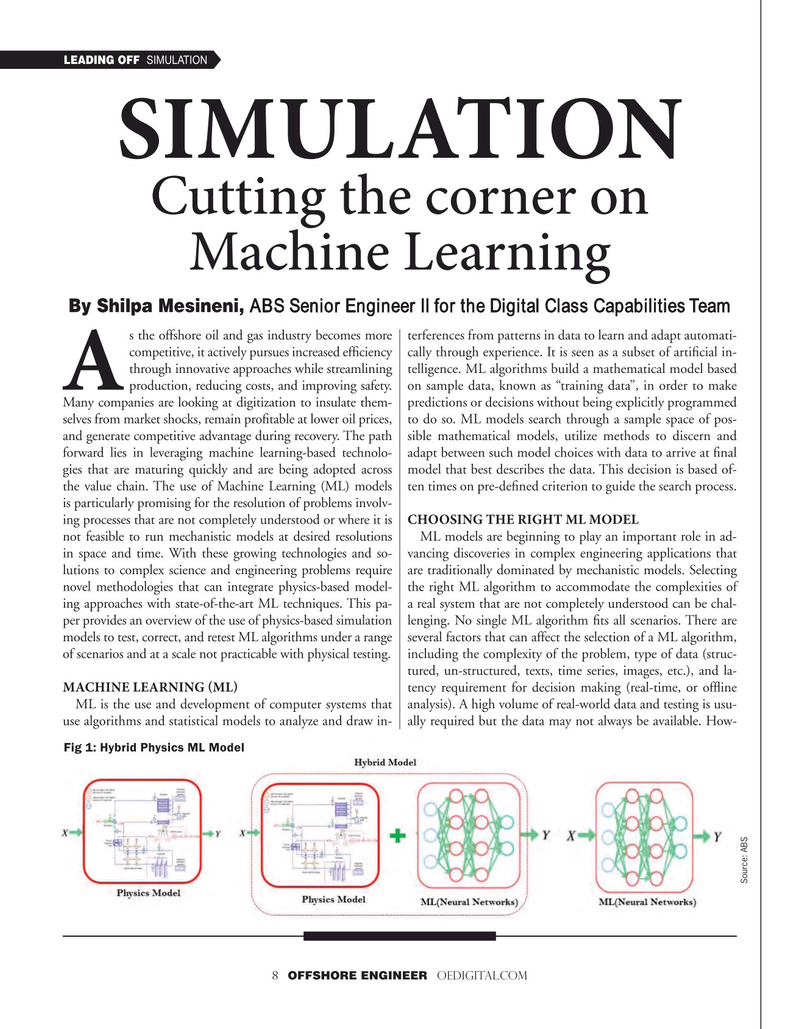
Page 8: of Offshore Engineer Magazine (Mar/Apr 2021)
Offshore Wind Outlook
Read this page in Pdf, Flash or Html5 edition of Mar/Apr 2021 Offshore Engineer Magazine
LEADING OFF SIMULATION
SIMULATION
Cutting the corner on
Machine Learning
By Shilpa Mesineni, ABS Senior Engineer II for the Digital Class Capabilities Team s the offshore oil and gas industry becomes more terferences from patterns in data to learn and adapt automati- competitive, it actively pursues increased effciency cally through experience. It is seen as a subset of artifcial in- through innovative approaches while streamlining telligence. ML algorithms build a mathematical model based
A production, reducing costs, and improving safety. on sample data, known as “training data”, in order to make
Many companies are looking at digitization to insulate them- predictions or decisions without being explicitly programmed selves from market shocks, remain proftable at lower oil prices, to do so. ML models search through a sample space of pos- and generate competitive advantage during recovery. The path sible mathematical models, utilize methods to discern and forward lies in leveraging machine learning-based technolo- adapt between such model choices with data to arrive at fnal gies that are maturing quickly and are being adopted across model that best describes the data. This decision is based of- the value chain. The use of Machine Learning (ML) models ten times on pre-defned criterion to guide the search process. is particularly promising for the resolution of problems involv- ing processes that are not completely understood or where it is CHOOSING THE RIGHT ML MODEL not feasible to run mechanistic models at desired resolutions ML models are beginning to play an important role in ad- in space and time. With these growing technologies and so- vancing discoveries in complex engineering applications that lutions to complex science and engineering problems require are traditionally dominated by mechanistic models. Selecting novel methodologies that can integrate physics-based model- the right ML algorithm to accommodate the complexities of ing approaches with state-of-the-art ML techniques. This pa- a real system that are not completely understood can be chal- per provides an overview of the use of physics-based simulation lenging. No single ML algorithm fts all scenarios. There are models to test, correct, and retest ML algorithms under a range several factors that can affect the selection of a ML algorithm, of scenarios and at a scale not practicable with physical testing. including the complexity of the problem, type of data (struc- tured, un-structured, texts, time series, images, etc.), and la-
MACHINE LEARNING (ML) tency requirement for decision making (real-time, or offine
ML is the use and development of computer systems that analysis). A high volume of real-world data and testing is usu- use algorithms and statistical models to analyze and draw in- ally required but the data may not always be available. How-
Fig 1: Hybrid Physics ML Model
Source: ABS 8 OFFSHORE ENGINEER OEDIGITAL.COM

 7
7

 9
9